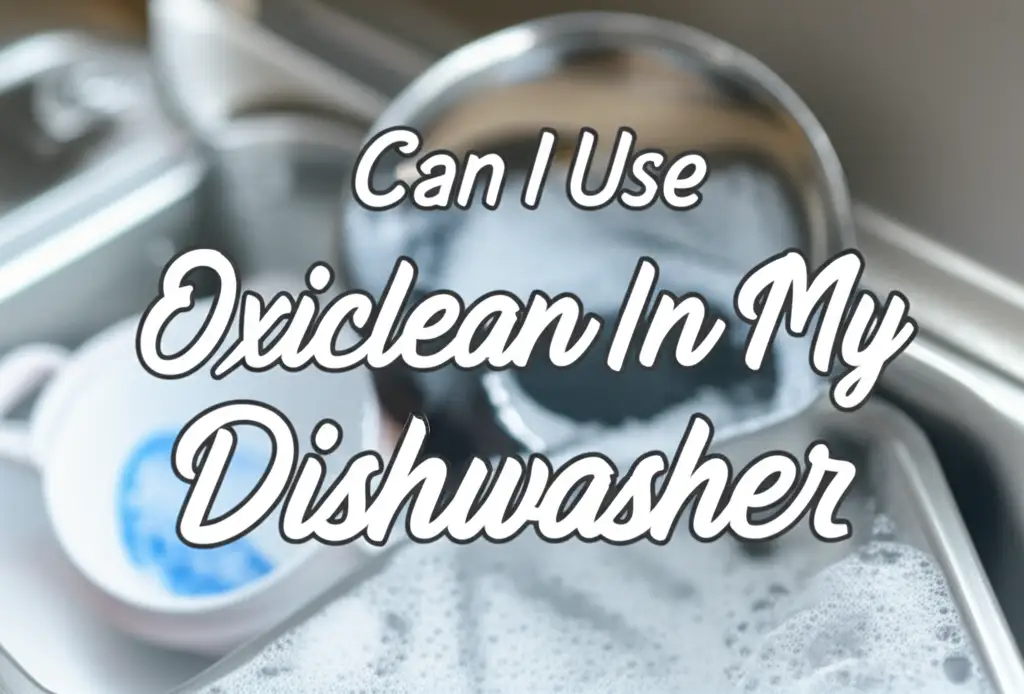· Mason Everett · Home Care · 20 min read
Can I Use Oxiclean In My Dishwasher

Unlock Clean Dishes: OxiClean in Your Dishwasher?
You stand in front of your dishwasher. Dishes sit inside, still showing spots, or perhaps the machine itself smells a little off. You glance at a tub of OxiClean, a powerful cleaner for many things. A thought sparks: “Can I use OxiClean in my dishwasher?” This is a common question. Many people wonder if this popular stain remover can help with dishwashing tasks. I have certainly asked myself this same question many times.
Using OxiClean in your dishwasher can be effective for certain cleaning needs. It offers a powerful way to tackle tough stains on dishes. It can also help to clean the dishwasher itself. However, you need to know how to use it safely. This article will explore everything you need to know. We will discuss the benefits and potential risks. You will learn the best ways to incorporate OxiClean into your dishwashing routine.
Takeaway
- OxiClean is safe for deep cleaning your empty dishwasher.
- You can use a small amount as an additive to boost regular detergent.
- Do not use OxiClean as a substitute for dishwasher detergent.
- Measure OxiClean carefully to avoid too many suds.
- Always check your dishwasher manual before using new cleaners.
Using OxiClean in your dishwasher is generally safe for cleaning the machine itself and some tough dish stains. Do not use it as a primary detergent. Add a small amount directly to the dishwasher tub for a deep clean or to boost your regular detergent for heavy-duty loads. Always check your dishwasher manual first.
Understanding OxiClean: What It Is and How It Works
OxiClean is a popular stain remover. It uses the power of oxygen to clean. People use it for laundry, carpet, and many other household cleaning tasks. Understanding its components helps you see why it works well. It also explains how to use it safely in various settings.
The Science Behind OxiClean’s Power
OxiClean’s main ingredient is sodium percarbonate. This compound is a mix of hydrogen peroxide and sodium carbonate, which is also known as soda ash. When sodium percarbonate mixes with water, it breaks down. It releases oxygen bubbles. These oxygen bubbles create a powerful cleaning action. They lift stains and dirt from surfaces. This process is called oxidation.
Sodium carbonate acts as a water softener. It also boosts the cleaning power of the hydrogen peroxide. This combination makes OxiClean effective against many types of stains. It works on food stains, grease, and grime. The product is also chlorine-free. This makes it different from traditional bleach. Chlorine bleach can be harsh. OxiClean is generally safer for colors and various materials. Its cleaning action is gentler. Yet, it remains very powerful.
Distinguishing OxiClean from Other Cleaners
OxiClean is an oxygen-based cleaner. This sets it apart from chlorine bleach. Chlorine bleach sanitizes and whitens. But it can also damage certain fabrics or finishes. It has a strong odor. OxiClean brightens and removes stains without chlorine. This means it is often safer for a wider range of materials. It also generally has no strong chemical smell.
Dishwasher detergents are formulated for dishwashers. They create controlled suds. They also contain specific enzymes to break down food. They have rinse aids. OxiClean is a booster. It does not have all these properties. It focuses on oxygen action for stains. You should not use it as a complete replacement for your dishwasher detergent. Its purpose is to enhance cleaning, not to be the sole cleaner. This distinction is important for proper use.
Dishwasher Mechanics: Why Compatibility Matters
Your dishwasher is a complex appliance. It works by combining hot water, specialized detergent, and powerful spray arms. These elements work together to get your dishes clean. Understanding how a dishwasher operates helps you see why certain cleaners work and others do not. This knowledge also explains why compatibility with cleaners is crucial.
How a Dishwasher Cleans Your Dishes
A typical dishwasher fills with water. Then, it heats the water to a high temperature. Detergent dispenses at specific times during the wash cycle. Spray arms shoot jets of hot, soapy water onto the dishes. This action loosens and washes away food particles. The water then drains. Fresh water fills the machine for rinsing cycles. Finally, a heating element dries the dishes.
Each part of this system is important. The spray arms need to spin freely. The heating element must heat water efficiently. The drain pump must clear water away. The filter captures food debris. This prevents it from redepositing on dishes. All these parts work in harmony. They ensure your dishes come out sparkling clean. Any disruption to this balance can cause problems.
The Role of Specialized Dishwasher Detergents
Dishwasher detergents are not like hand dish soap. They are specially formulated. They produce very few suds. High suds can cause significant problems. Too many suds can overflow the dishwasher. They can also damage internal components. Dishwasher detergents contain enzymes. These enzymes break down tough food stains. They also include phosphates or phosphate-free alternatives. These help prevent water spots.
These detergents are designed to work in a hot, enclosed environment. They ensure residue-free rinsing. Using the wrong type of soap, like hand dish soap, can create a mountain of suds. This can harm your machine. It can also create a huge mess. This is why you must use only products made for dishwashers. You can learn more about specific detergent types by reading about can you use pods in samsung dishwasher. This helps you choose the right product for your appliance.
Protecting Your Dishwasher’s Components
The internal parts of a dishwasher are sensitive. They include rubber seals, plastic components, and metal heating elements. Harsh chemicals can degrade these materials over time. Acids can corrode metal. Excessive suds can strain the motor and pump. They can also push water into areas it should not go. This causes damage.
Manufacturers design dishwashers for specific cleaning agents. Using non-compatible cleaners voids warranties. It can also shorten your appliance’s lifespan. You need to consider the long-term health of your machine. This means choosing cleaning products carefully. Always err on the side of caution. Protect your investment. Understanding these mechanics is key. It guides your decision on what to put inside your dishwasher.
Using OxiClean for Dishwasher Cleaning (Machine Maintenance)
Your dishwasher cleans your dishes. But, it also needs cleaning itself. Food particles, grease, and hard water minerals can build up inside the machine. This buildup can lead to odors. It can also reduce cleaning performance. OxiClean can be an excellent tool for deep cleaning your dishwasher. It helps remove this stubborn grime.
Step-by-Step Guide to Cleaning Your Dishwasher
Cleaning your dishwasher with OxiClean is simple. First, make sure your dishwasher is empty. Do not put any dishes inside. This allows the OxiClean to focus on cleaning the machine itself. Locate the detergent dispenser. You will not use this for OxiClean directly.
Instead, sprinkle a quarter cup of OxiClean powder directly onto the bottom of the empty dishwasher tub. Close the door firmly. Select the hottest and longest cycle available. A “heavy duty” or “pots and pans” cycle works well. Let the dishwasher run through its complete cycle. The hot water activates the OxiClean. It releases oxygen bubbles. These bubbles scrub away grime and residue.
After the cycle finishes, open the dishwasher. Look inside. You should see a noticeable improvement. The interior walls will look cleaner. The racks will shine more. Any unpleasant odors should be gone. This simple process can revive your dishwasher’s performance.
Targeting Specific Dishwasher Buildup
OxiClean is very effective against certain types of buildup. It excels at breaking down grease and food residue. These often accumulate in the filter and spray arms. It also helps with hard water stains. The oxygen action lifts mineral deposits. This makes them easier to rinse away.
You might notice white, chalky residue inside your dishwasher. This is from hard water. OxiClean can reduce this buildup. For tough spots, you can make a paste with OxiClean and water. Apply it directly to the affected area. Let it sit for a few minutes. Then, wipe it away with a damp cloth. Run a cycle afterward to rinse thoroughly.
Regular cleaning prevents these issues from becoming severe. I always make sure to clean my dishwasher about once a month. This keeps it running smoothly and smelling fresh. Remember, a clean dishwasher cleans dishes better. If you have concerns about mold, OxiClean can help. It breaks down organic matter. This reduces mold and mildew growth. You can learn more about how to tackle mold by reading about how to clean mold off dishwasher.
Frequency and Best Practices for Maintenance
How often should you clean your dishwasher with OxiClean? This depends on your usage. If you use your dishwasher daily, cleaning it once a month is a good idea. If you use it less often, every two to three months might suffice. Pay attention to signs of buildup. These include odors, diminished cleaning power, or visible residue.
Beyond OxiClean, remember other maintenance tasks. You should regularly clean your dishwasher filter. This is a crucial step. A clogged filter traps food particles. This leads to odors and poor cleaning. Most filters are easy to remove and rinse under the tap. You can learn more about this by reading how often should you clean your dishwasher filter.
Wipe down the door gasket. Food and grime can collect here. This area can also harbor mold. A simple wipe-down with a damp cloth and a little dish soap works wonders. These small, consistent efforts keep your dishwasher in top condition. They ensure it lasts longer. They also ensure your dishes always come out perfectly clean.
Can OxiClean Boost Your Dishwashing Detergent? (For Dishes)
You might wonder if OxiClean can give your regular dishwashing detergent an extra kick. The answer is yes, sometimes. OxiClean is a powerful stain remover. It can enhance your dishwasher’s performance on very dirty dishes. However, it is important to use it correctly. It serves as an additive, not a replacement.
When to Consider Adding OxiClean to a Load
You might consider adding OxiClean for specific situations. If your dishes have stubborn, baked-on food, OxiClean can help. It works well on coffee and tea stains in mugs. It tackles dried-on sauce. Dishes that have sat for a while with food stuck on them also benefit. OxiClean can also help if you have hard water. Hard water leaves mineral deposits and spots on dishes. The oxygen action in OxiClean helps break down these minerals.
Adding OxiClean is not necessary for every load. Your regular dishwasher detergent handles most everyday cleaning tasks. Save OxiClean for those particularly challenging loads. Think of it as a booster shot for your detergent. It gives an extra surge of cleaning power when needed. This approach saves money. It also prevents overuse of powerful chemicals.
How Much to Add and Where to Put It
The key to using OxiClean for dishes is moderation. You need only a small amount. Too much can cause problems. I recommend adding just one teaspoon of OxiClean powder. You can add it directly to the bottom of the dishwasher tub. Sprinkle it before starting the wash cycle.
Some people add it to the pre-wash detergent cup. This works too. However, placing it directly in the tub ensures it dissolves immediately. It also mixes with the water from the start. This gives it more time to work on tough stains. Never fill the main detergent dispenser with OxiClean. That dispenser is for your primary detergent only. Using too much OxiClean can lead to excessive suds. This is something you want to avoid in your dishwasher.
Effectiveness on Specific Types of Stains
OxiClean is highly effective against organic stains. This includes coffee, tea, wine, and food dyes. It also works on protein-based stains like egg or dairy residue. The active oxygen breaks down the bonds holding these stains to the dish surface. This makes them easier for your detergent to wash away.
For glassware, OxiClean can help remove cloudiness. This cloudiness often comes from hard water minerals. The oxygen action can lift these deposits. It restores clarity to your glasses. However, for etching or permanent damage from hard water, OxiClean may not fully restore the glass. It works best on mineral buildup. It is a powerful helper for truly stubborn dish dilemmas.
Potential Risks and Downsides of Using OxiClean in Dishwasher
While OxiClean offers great cleaning power, it is not without its risks when used in a dishwasher. Knowing these potential downsides helps you use the product safely. It prevents damage to your appliance and your dishes. Every powerful cleaning agent requires careful handling.
Excessive Sudsing and Appliance Damage
The biggest risk of using OxiClean in a dishwasher is excessive sudsing. OxiClean, like many oxygen cleaners, can create a lot of foam. Dishwashers are designed to work with low-sudsing detergents. Too many suds can lead to several problems. The suds can overflow the dishwasher. This creates a messy situation on your kitchen floor.
Beyond the mess, excessive suds can strain your dishwasher’s motor and pump. The motor has to work harder to circulate foamy water. This can lead to premature wear and tear. Suds can also block spray arms. This prevents proper cleaning of your dishes. In severe cases, too much suds can push water into electrical components. This causes short circuits or permanent damage. For example, if you mistakenly put hand soap in, you would have a similar problem. Read about what to do if you put dawn in dishwasher for a clear idea of sudsing issues. This is why strict adherence to recommended amounts is crucial.
Damage to Dishwasher Components
While OxiClean is generally safe for many surfaces, repeated or improper use can affect dishwasher components. Rubber seals and gaskets can degrade over time. The chemicals in OxiClean, especially in high concentrations, might accelerate this process. This leads to leaks. The heating element is also sensitive. While OxiClean is not directly corrosive, residual powder or chemical reactions could theoretically affect its surface.
Plastic parts inside the dishwasher can become brittle or discolored. Stainless steel interiors are generally robust. However, any cleaner left on surfaces for too long could potentially leave streaks or dull finishes. Always ensure OxiClean dissolves completely. Always run a full rinse cycle. This prevents any residues from lingering. Protecting your appliance means using products as intended.
Harm to Delicate Dishware
OxiClean is powerful. This means it might be too strong for some delicate items. Hand-painted dishes, antique china, or items with metallic accents can be vulnerable. The oxygen bleaching action might fade colors. It could strip away delicate finishes. It could also etch certain types of glass. This is especially true if the glass is already damaged or old.
Silverware, particularly sterling silver, can also react. OxiClean might cause discoloration or dullness. Always avoid using OxiClean with silver. When in doubt, hand wash delicate items. Or, test OxiClean on an inconspicuous area first. If you are cleaning a load with a mix of items, consider skipping the OxiClean boost. Prioritize the safety of your dishes over aggressive stain removal. It is always better to be safe than sorry with cherished items.
Safe Practices and Alternatives for Sparkling Dishes
Using your dishwasher effectively means more than just loading dishes. It involves smart choices about detergents and cleaning habits. You can achieve sparkling clean dishes and a fresh-smelling dishwasher without unnecessary risks. Safe practices and knowing your alternatives are key.
Always Consult Your Dishwasher Manual
Your dishwasher manual is your best guide. It contains specific instructions from the manufacturer. These instructions cover recommended detergents. They explain loading patterns. They also list any warnings about specific cleaners. Some manuals might explicitly state not to use certain oxygen-based boosters. Others might give guidelines.
Before trying any new product like OxiClean, take a moment to read your manual. This simple step can prevent expensive repairs. It also ensures your warranty remains valid. Manufacturers design their appliances for optimal performance with specific product types. Adhering to their advice is always the safest bet. My own dishwasher manual has saved me from making many mistakes over the years.
Proper Detergent Use and Rinse Aid Importance
Using the correct amount of high-quality dishwasher detergent is fundamental. Do not overfill the dispenser. Too much detergent can leave residue on dishes. Too little might not clean properly. Choose a detergent specifically for dishwashers. These products are formulated to be low-sudsing and effective in high-heat environments.
Rinse aid is also critical. It helps water sheet off dishes. This prevents water spots and streaks. It also aids in drying. If your dishes often come out wet or spotted, you might need more rinse aid. Most dishwashers have a dedicated rinse aid dispenser. Fill it regularly. This simple addition makes a huge difference in shine and dryness.
Natural Alternatives for Dishwasher Cleaning
If you are cautious about using OxiClean or want a more natural approach, several alternatives exist. White vinegar is a popular choice. It acts as a natural descaler. It cuts through grease and helps remove odors. You can place a cup of white vinegar on the top rack of an empty dishwasher. Then, run a hot cycle. This method is effective for maintaining cleanliness and shine. You can learn more details on where to put vinegar in dishwasher to clean.
Baking soda is another natural option. It absorbs odors and helps scour away grime. Sprinkle half a cup of baking soda on the bottom of your empty dishwasher. Run a short, hot cycle. Baking soda can also be used in combination with vinegar. For really tough clogs or drainage issues, sometimes the problem is beyond simple cleaning. If you encounter issues, learning how to get the dishwasher to drain can be helpful. These natural options offer a gentler way to keep your dishwasher clean and fresh.
Expert Tips for Optimal Dishwasher Performance
Getting the best performance from your dishwasher goes beyond just adding soap. A few simple practices can make a big difference. These tips help your machine work more efficiently. They also ensure your dishes come out consistently clean and sparkling. Integrating these habits into your routine will benefit you greatly.
Scraping Versus Rinsing Dishes
There’s an ongoing debate: should you rinse dishes before loading them into the dishwasher? Most modern dishwashers and detergents are designed for scraping, not rinsing. You should scrape off large food particles into the trash. This includes bones, excessive sauces, and solid waste. This prevents the filter from getting clogged.
However, avoid pre-rinsing dishes thoroughly. Dishwasher detergents need some food residue to work effectively. The enzymes in the detergent latch onto food particles and break them down. If dishes are too clean, the detergent can become over-aggressive. This may cause etching on glassware or leave a film. So, just scrape and load.
Loading Efficiency for Maximum Cleanliness
How you load your dishwasher significantly impacts cleaning results. Do not overcrowd the racks. Overlapping dishes block water jets. This prevents water and detergent from reaching all surfaces. Ensure spray arms can spin freely. Tall items should go in the lower rack. Place bowls and plates facing the center. This allows water to hit them directly.
Cups and glasses go in the upper rack. Position them at an angle. This allows water to drain effectively. Silverware should be mixed in the basket. Some facing up, some facing down. This prevents nesting. Follow these simple loading rules. They ensure every dish gets thoroughly cleaned. This maximizes the efficiency of each wash cycle.
Water Temperature Considerations
The temperature of the water is vital for effective dishwashing. Most dishwashers heat water to an optimal temperature. This temperature is usually around 120-140°F (49-60°C). Hot water helps dissolve detergent more effectively. It also sanitizes dishes. It helps melt grease and oil.
If your hot water heater is far from the kitchen, run the hot water tap in your sink for a minute before starting the dishwasher. This ensures the dishwasher fills with already hot water. This gives the detergent an immediate boost. It also ensures proper cleaning from the start of the cycle. Cold water will not activate detergents as well.
Understanding Dishwasher Cycles
Modern dishwashers offer various cycles. Understanding them helps you choose the right one.
- Normal wash: This cycle is for everyday loads. It cleans most dish types.
- Heavy duty: Use this for pots, pans, and very dirty dishes. It uses more water and a longer wash time.
- Light wash/Quick wash: This cycle is for lightly soiled dishes. It is shorter. It saves water and energy. It may not fully clean heavily soiled items.
- Sanitize: This cycle uses extra hot water. It kills bacteria. It is good for baby bottles or after illness.
- Rinse only: Use this if you are not running a full cycle immediately. It prevents food from drying onto dishes.
Choosing the right cycle saves energy and water. It also ensures your dishes get the proper cleaning they need. Always match the cycle to the soil level of your dishes.
Routine Maintenance Schedule
A consistent maintenance schedule keeps your dishwasher running smoothly for years. Beyond occasional OxiClean deep cleans, make these tasks a habit:
- Daily: Scrape dishes. Do not pre-rinse.
- Weekly: Wipe down the door gasket. Check for food debris.
- Monthly: Clean the filter. Run a hot cycle with vinegar or OxiClean.
- Annually: Inspect spray arms for clogs. Clear any blockages. Check water supply lines for leaks.
Following this schedule helps prevent common dishwasher problems. It extends the life of your appliance. It also guarantees consistently clean dishes. Good maintenance is key to a reliable dishwasher.
FAQ Section
Is OxiClean safe for all dishwasher models?
OxiClean is generally safe for most dishwasher models. However, always check your specific dishwasher’s manual first. Some manufacturers might have warnings against certain chemical types. Use OxiClean sparingly and avoid using it as a direct detergent replacement. It is designed as a booster or for machine cleaning.
Can OxiClean remove hard water stains in the dishwasher?
Yes, OxiClean can effectively remove hard water stains. The oxygen bubbles help break down mineral deposits. These often cause cloudiness inside the dishwasher and on glassware. Use it in an empty dishwasher cycle for best results. This targets the machine’s interior surfaces directly.
How often should I use OxiClean in my dishwasher?
For machine maintenance, using OxiClean once a month is a good general guideline. If you have particularly hard water or notice odors, you might do it more often. As a detergent booster for dishes, use it only for heavily soiled loads. Avoid using it in every cycle.
Will OxiClean damage my dishes?
OxiClean can be too strong for very delicate items. This includes hand-painted china, antique glassware, or certain metallic finishes. It can cause fading or etching. It is not recommended for silver. For everyday dishes, a small amount as a booster is generally safe.
Can I use OxiClean instead of dishwasher detergent?
No, you should not use OxiClean instead of regular dishwasher detergent. OxiClean is a stain remover and booster. It does not contain all the necessary enzymes, surfactants, and suds inhibitors found in dishwasher detergents. Using it alone can lead to excessive suds and poor cleaning results.
Conclusion
The question, “Can I use OxiClean in my dishwasher?” has a clear answer. Yes, you can use OxiClean in your dishwasher. It works wonderfully for specific cleaning tasks. It excels at deep cleaning the machine itself. It also provides a powerful boost for tough stains on dishes. However, responsible use is crucial. Always remember it is an additive, not a primary detergent.
I have found that a little OxiClean goes a long way. Using a small amount directly in the tub for machine cleaning works wonders. A tiny bit added to a heavily soiled dish load can make dishes sparkle. Always measure carefully to avoid excessive suds. Consulting your dishwasher’s manual is also a must. This ensures you protect your appliance.
By following these guidelines, you can safely harness OxiClean’s power. Your dishwasher will





